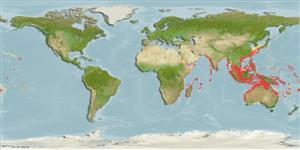Common names from other countries
>
Carangaria/misc (Various families in series Carangaria) >
Polynemidae (Threadfins)
Etymology: Polydactylus: Greek, poly = a lot of + greek, daktylos = finger (Ref. 45335).
Issue
Genus Eschmeyer, pers. comm.
Environment: milieu / climate zone / depth range / distribution range
Οικολογία
Θαλασσινό(ά); Υφάλμυρο βενθικό(ς); εύρος βάθους ? - 122 m (Ref. 57343). Tropical; 37°N - 35°S, 22°E - 148°W (Ref. 57343)
Indo-Pacific: East Africa to French Polynesia, north to Japan, south to Australia. Has not been collected from the Red Sea or Persian Gulf (Ref. 57343).
Μέγεθος / Βάρος / Age
Maturity: Lm ? range ? - ? cm
Max length : 45.0 cm SL αρσενικό/απροσδιόριστο; (Ref. 57343); common length : 30.0 cm TL αρσενικό/απροσδιόριστο; (Ref. 30573); μεγ. δημοσιευμένο βάρος: 1.7 kg (Ref. 40637)
Ραχιαίες άκανθες (συνολικά) : 9; Μαλακές ραχιαίες ακτίνες (συνολικά) : 13; Εδρικές άκανθες: 2; Μαλακές εδρικές ακτίνες: 11 - 12. Golden, dusky olive brown above, scale rows each with a dark line; fins dusky (Ref. 5492). Body with 7 or 8 prominent dark stripes along the longitudinal scale rows above lateral line and 7-9 faint stripes below. Pectoral fin rays unbranched; 4th or 5th pectoral filament longest, 22-40% of SL. Posterior margin of maxilla reaching to (or slightly extending beyond) level of posterior margin of adipose eyelid. Lower tip of 7th proximal pterygiophore of 1st dorsal fin directed backwards. Lateral squamation on caudal fin unbranched (Ref. 40970).
Occur over muddy bottoms of the continental shelf (Ref. 4340), from estuaries to coastal beaches and to relatively deep waters (less than 122 m) (Ref. 57343). Forms loosely-associated schools (Ref. 57343). Feeds on small crustaceans, fishes and other benthic organisms (Ref. 30573). Fish of 12 cm can be caught in large numbers (Ref. 9685).
Life cycle and mating behavior
Maturities | Αναπαραγωγή | Spawnings | Egg(s) | Fecundities | Προνύμφες
Motomura, H., 2004. Threadfins of the world (Family Polynemidae). An annotated and illustrated catalogue of polynemid species known to date. FAO Spec. Cat. Fish. Purp. Rome: FAO. 3:117 p. (Ref. 57343)
IUCN Red List Status (Ref. 130435)
CITES (Ref. 128078)
Not Evaluated
Threat to humans
Harmless
Human uses
αλιεία: Εμπορικό(ά); Υδατοκαλλιέργειες: Εμπορικό(ά); αλιεία αναψυχής: ναί
Εργαλεία
Special reports
Download XML
Διαδικτυακές πηγές
Estimates based on models
Preferred temperature (Ref.
115969): 23.5 - 29.1, mean 28 (based on 2216 cells).
Phylogenetic diversity index (Ref.
82804): PD
50 = 0.5000 [Uniqueness, from 0.5 = low to 2.0 = high].
Bayesian length-weight: a=0.00851 (0.00489 - 0.01483), b=3.07 (2.91 - 3.23), in cm Total Length, based on LWR estimates for this species & (Sub)family-body (Ref.
93245).
Τροφικό Επίπεδο (Ref.
69278): 3.6 ±0.50 se; based on food items.
Ελαστικότητα (Ref.
120179): Υψηλό, ελάχιστος χρόνος για διπλασιασμό πληθυσμού < 15 μήνες (Preliminary K or Fecundity.).
Fishing Vulnerability (Ref.
59153): Moderate vulnerability (42 of 100).
